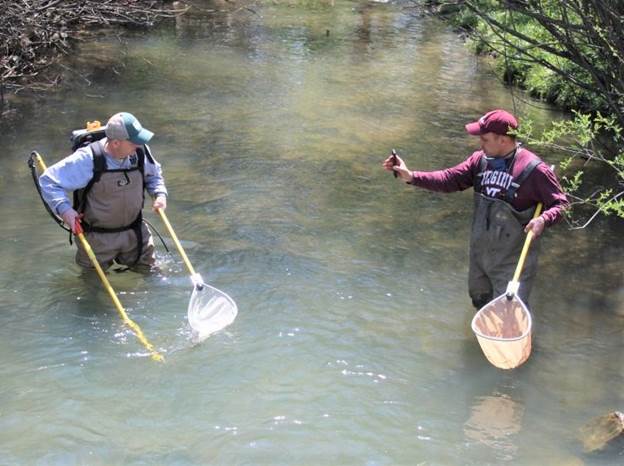
Photo courtesy of VT – While practicing social distancing, Kevin Hamed, right, live-streams a field exercise for his students with the help of Mike Pinder of the Virginia Department of Game and Inland Fisheries.
For Kevin Hamed of Virginia Tech’s College of Natural Resources and Environment jumping into a stream to collect fish while holding his phone was a small price to pay to give his students an experience close to the hands-on work traditionally done in his wildlife field biology course.
“We wanted our students to have a similar experience,” said Hamed, collegiate assistant professor in the Department of Fish and Wildlife Conservation. “From slipping on rocks to everything that goes along with getting in the water, we wanted to make sure that our students would have a good understanding of the steps to collect samples and the methodology behind it.”
Hamed was able to capture a few fish, and he had aquariums set up along Stroubles Creek to allow students to identify the specimens. He has also utilized his department’s wildlife specimen collection, giving students the opportunity to practice their identification skills from the comforts of home while still being able to ask questions and engage with their professor.
“I work with predominantly second-year students, and my job is to ignite their passion so that the rest of their educational journey takes care of itself,” Hamed said. “The challenge has been how to keep students engaged in this new territory.”
To adjust to the new landscape of digital classrooms, faculty in the College of Natural Resources and Environment and all across campus have had to find new ways to keep their students engaged and on task while being adaptive to the challenges of moving classes online.
“I’ve worked to engage with students, but I’ve also tried not to stress them out,” said Assistant Professor J.P. Gannon, who teaches environmental informatics in the Department of Forest Resources and Environmental Conservation. “My approach has been to work on the challenges in a direct way, trying to get my students to talk with me.”
To facilitate that conversation, Gannon conducted multiple surveys to gauge how the adjustments to video lectures and labs have gone for his students and where he could make improvements. “When you’re up in front of the class, you can adjust on the fly if you get the sense that something isn’t connecting,” he said. “You can’t get that same sense lecturing online, so it’s important to have ways to get feedback that you can use to make adjustments.”
Gannon also used class surveys to lighten things up for students, creating avenues for students to brainstorm ideas for staying busy in this uncertain moment.
“I did a survey asking students what they were doing to take their mind off things and asked if I could share their answers with classmates so we’d have a list of ideas,” Gannon said. “I made a slideshow with some of the strategies the students mentioned, from exercising and dancing, to playing Animal Crossing, or building forts. I even put in slides of what I’ve been doing, whether it’s riding my bike or playing with my dogs. I think they appreciated knowing we’re all in this together.”
Much of the learning that takes place in the college is hands-on and outdoors, and professors are striving to make sure that students can still access some of the resources that are on campus or nearby.
“Our forest resources field experience course entails field labs taught by several faculty members,” said Associate Professor Eric Wiseman, who teaches urban forestry. “The lab that I teach each year is our first opportunity to expose students to the professions of urban forestry and arboriculture. In the past I’ve arranged to bring four or five arborists and urban foresters to the Hahn Horticulture Garden and have set up field stations where they teach and demonstrate techniques of the professions.”
To give current sophomores a chance to learn about the professions, Wiseman conducted a virtual urban forestry day, inviting arborists and urban foresters with a variety of backgrounds to participate in a Zoom class and round-robin discussion about the field and how students can prepare for careers in forestry.
“We had a municipal forester, a commercial arborist, a consulting arborist and a utility forester participate in the session,” Wiseman said. “They talked to the students about some of the things they do in their sectors of the field, and it was an opportunity for our students to ask questions of professionals.”
For his wildlife fire ecology lab, Assistant Professor Adam Coates took his students to the field virtually. “I visited outdoor field locations in Fishburn Forest and the Jefferson National Forest where the students would have observed potential fire effects and prepared videos of what those labs would have entailed,” he said.
In addition to being more innovative in the virtual classroom, researchers in the college are also adapting to the changing circumstances. For social scientists especially, who rely on face-to-face interviews with individuals or groups, the coronavirus pandemic has forced radical rethinking about how to safely conduct research.


